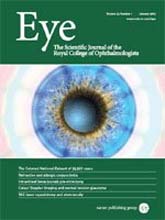'Quality of life and visual rehabilitation: an observational study of low vision in three general practices in West Glamorgan
Abstract
AIM:
To survey low vision in an urban population and assess impact on quality of life, rehabilitation and support.
METHODS:
In a cross-sectional population survey, 66 patients were identified from databases of three general practices and surveyed by investigator administered questionnaire. Main outcome measures were ocular diagnoses, (US) National Eye Institute Visual Function-Questionnaire (NEI-VFQ) scores assessing visual and nonvisual disability, eligibility for, awareness and receipt of rehabilitation and support.
RESULTS:
Of 24,420 individuals on the lists of the three study practices, we found 101 registered as blind or partially sighted (prevalence 0.41%). A total of 66 patients participated with ocular diseases of age-related macular degeneration 39 (59%), glaucoma 11 (17%), diabetic retinopathy two (3%), retinitis pigmentosa two (3%), and 12 (18%) ‘others’. Better eye visual acuity was counting fingers or worse in 32 (48.5%). NEI-VFQ scores were poor-overall mean 41.5% (SD 23.5). In all, 80% had a social services home visit with one-third of these still in contact. In all, 66% had undergone a low vision aid assessment and 57.6% of these used their aid. The awareness and receipt of benefits arising from registration as visually impaired were lower than for other supportive measures available for reasons unrelated to vision. None had a guide dog.
CONCLUSIONS:
We found expected patterns of low vision but poorer levels of function and support that may reflect age and deprivation in a population failed by the current systems for identification, registration, and rehabilitation based on legislation overtaken by demographic change and social provision independent of visual status.



